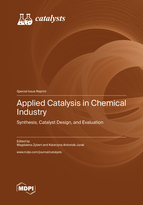Applied Catalysis in Chemical Industry: Synthesis, Catalyst Design, and Evaluation
A special issue of Catalysts (ISSN 2073-4344). This special issue belongs to the section "Industrial Catalysis".
Deadline for manuscript submissions: closed (30 September 2022) | Viewed by 25254
Special Issue Editors
Interests: heterogeneous catalysis; catalyst preparation; catalyst characterization; ammonia synthesis; cobalt catalysts; thermal analysis; sorption techniques; materials chemistry
Special Issues, Collections and Topics in MDPI journals
Interests: heterogeneous catalysis; synthesis and characterization of nanomaterials; scale-up of catalytic materials production; water gas shift and hydrogen production
Special Issue Information
Dear Colleagues,
Catalysis is very important in terms of sustainable development, energy production, environmental protection, food production, and water purification, among others. The practical importance of catalysis is due to the fact that almost 90% of the products of the chemical industry are produced by catalytic processes. The great economic and strategic importance of catalysis makes it a rapidly evolving field. In the face of the great challenges of the present day, the acquisition of fundamental knowledge about the structure and phenomena on catalysts’ surface as well as relationships between catalysts composition, synthesis method, properties, and their performance in industrial processes is essential. Research is still needed to improve existing catalysts or design new systems which may efficiently and selectively conduct a given reaction toward the desired product.
This Special Issue is devoted to the design and characterization of heterogeneous catalytic systems for industrial inorganic chemical processes. The aim is to collect the current state of knowledge, indicate areas requiring further research, and show the direction of ongoing development work. The main attention will be focused on comprehensive experimental studies of synthesis, characterization, and evaluation of catalyst performance in industrial processes such as, but not limited to, methane conversion, water–gas–shift reaction, ammonia synthesis, ammonia decomposition, carbon oxide methanation, selective catalytic reduction of nitrogen oxides, high-temperature N2O decomposition, and low-temperature N2O decomposition.
The scope also includes an investigation of catalysts under conditions close to the industrial ones, a comparison of the studied catalytic systems with the currently operating commercial systems, and a demonstration of the validity of their application in a given chemical process.
Dr. Magdalena Zybert
Dr. Katarzyna Antoniak-Jurak
Guest Editors
Manuscript Submission Information
Manuscripts should be submitted online at www.mdpi.com by registering and logging in to this website. Once you are registered, click here to go to the submission form. Manuscripts can be submitted until the deadline. All submissions that pass pre-check are peer-reviewed. Accepted papers will be published continuously in the journal (as soon as accepted) and will be listed together on the special issue website. Research articles, review articles as well as short communications are invited. For planned papers, a title and short abstract (about 100 words) can be sent to the Editorial Office for announcement on this website.
Submitted manuscripts should not have been published previously, nor be under consideration for publication elsewhere (except conference proceedings papers). All manuscripts are thoroughly refereed through a single-blind peer-review process. A guide for authors and other relevant information for submission of manuscripts is available on the Instructions for Authors page. Catalysts is an international peer-reviewed open access monthly journal published by MDPI.
Please visit the Instructions for Authors page before submitting a manuscript. The Article Processing Charge (APC) for publication in this open access journal is 2700 CHF (Swiss Francs). Submitted papers should be well formatted and use good English. Authors may use MDPI's English editing service prior to publication or during author revisions.
Keywords
- Industrial inorganic chemistry
- Nanomaterials
- Carbon nanomaterials
- Heterogeneous catalyst
- Catalyst synthesis
- Catalyst characterization
- Catalyst design
- Catalyst deactivation
- Thermodynamics and kinetics
- Modeling and simulation of catalytic reactors







